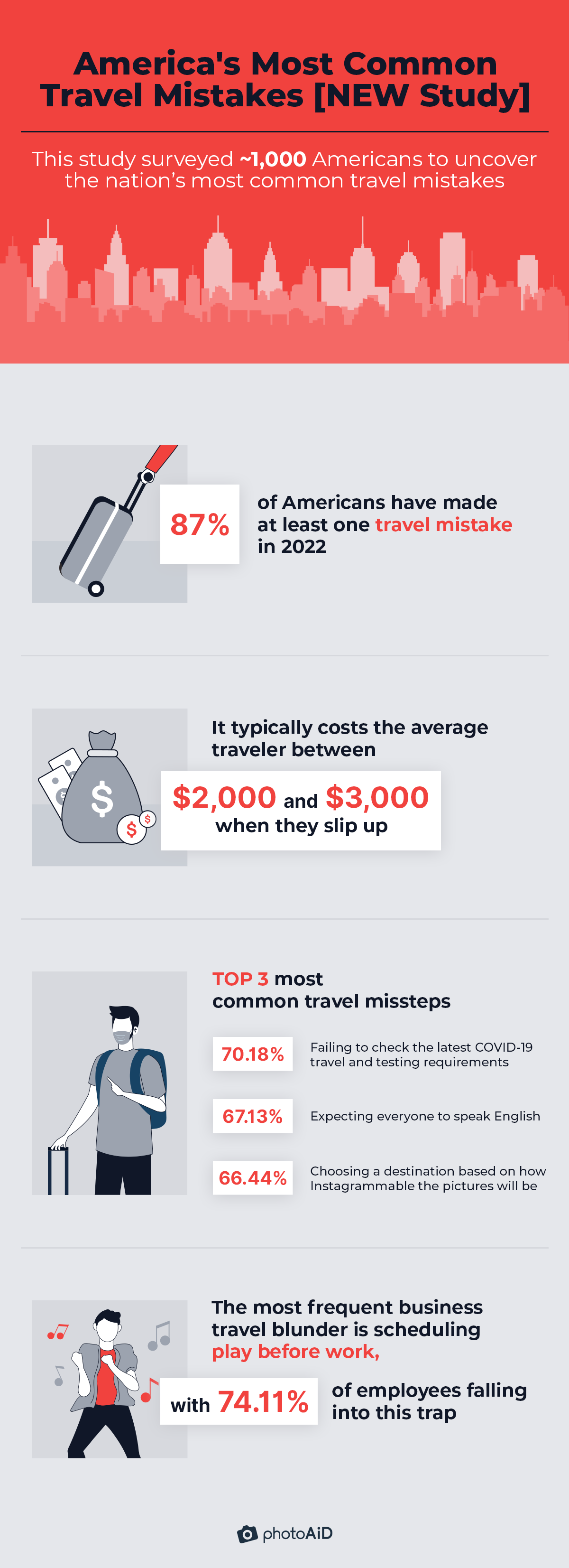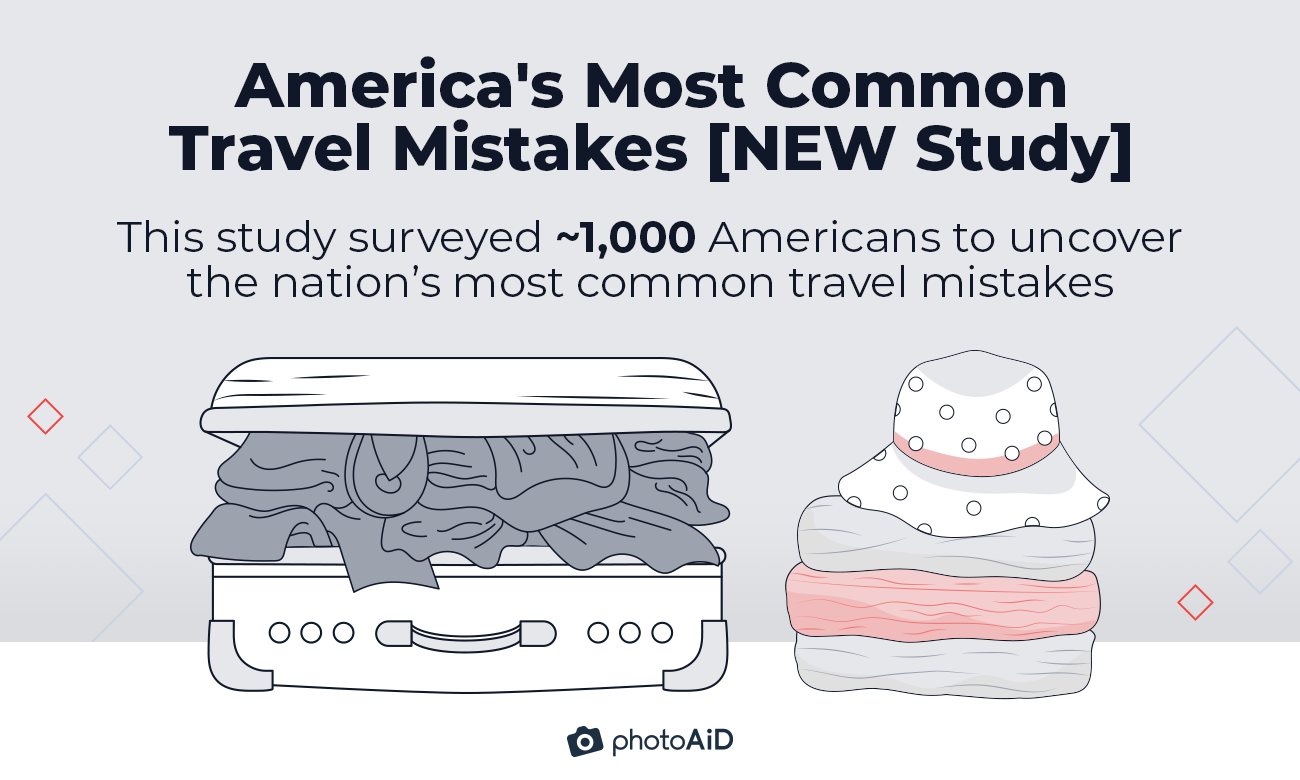We all make mistakes. It’s part of being human.
But—
When you’re on the road, even the slightest slip-up can lead to big problems.
So at PhotoAiD, we’ve decided to survey 1,000+ Americans to uncover the nation’s most common travel mistakes to help you avoid those Oops!.. moments.
Let’s make a start.
Key Takeaways

- 87% of Americans have made at least one travel mistake in 2022.
- It typically costs the average traveler between $2,000 and $3,000 when they slip up.
- America’s TOP three most common travel missteps are failing to check the latest COVID-19 travel and testing requirements (70%), expecting everyone to speak English (67%), and choosing a destination based on how Instagrammable the pictures will be (66%).
- The most frequent business travel blunder is scheduling play before work, with 74% of employees falling into this trap.
Most Americans Have Had a Mix-Up When Traveling in 2022
Picture this:
You’ve packed your bags and geared up for that long-awaited summer vacation. Your passport, tickets, and sombrero are all sorted out.
But—
When you arrive at the airport, you realize you forgot something important at home or, worse, booked the wrong days.
Ugh.
If that sounds familiar, you aren’t alone. We found that 87% of our respondents have had at least one mix-up of some kind when traveling in 2022.
Now, while some travel mistakes are just irksome, others can put a dent in your wallet. Here’s how much Americans paid for their lifetime biggest travel blunders:
| $2,000–$3,000 | 19% |
| $1,000–$2,000 | 17% |
| $3,000–$5,000 | 17% |
| $500–$1,000 | 16% |
| $300–$500 | 12% |
| $50–$300 | 9% |
| $5,000+ | 5% |
| $1–$50 | 3% |
As you can see, $2,000–$3,000 is the most common response, with roughly one in five travelers admitting they’ve shelled out this much when they slipped up.
That’s a lot of money!
The Top 10 Most Common Travel Mistakes, Ranked
So far, so good.
Now that we’ve seen that travel mix-ups aren’t few and far between, we wanted to pin down America’s most common travel mistakes.
To do it, we gave respondents a list of 26 travel missteps and asked them to check off the ones that apply to them.
Below are the results (along with the text version of just the TOP five):

| Travel Mistake | Yes, I’ve Made It | No, I Haven’t Made It | Yes, I’ve Made It, but I Don’t Consider It a Mistake |
|---|---|---|---|
| Failing to check the latest COVID-19 travel and testing requirements | 70.18% | 13.98% | 15.85% |
| Expecting everyone to speak English | 67.13% | 17.81% | 15.06% |
| Choosing a destination based on how Instagrammable the pictures will be | 66.44% | 16.54% | 17.03% |
| Booking non-refundable tickets/hotel reservations | 65.06% | 16.14% | 18.08% |
| Picking too tight connection time | 64.76% | 18.7% | 16.54% |
The data shows that the most frequent mistake is failing to check the latest COVID-19 travel and testing requirements, as 70% of respondents indicated. Coming a close second is “expecting everyone to speak English” at 67%, which most of us can probably relate to.
But—
What’s particularly fascinating is that a full 66% of survey takers (66% of men and 68% of women) have made the mistake of choosing a travel destination based on how Instagrammable the photos would turn out. That goes to show just how much social media can affect our travel decisions.
Finally, about two in 10 Americans (21%) stated that while they didn’t consider sustainability during travel, they believe they weren’t in the wrong.
That’s dispiriting.
After all, we need to start making sustainable travel choices if we want to protect our planet. That means considering the environment at every stage of the trip, from opting for greener modes of transportation to staying at eco-friendly accommodation.
So travelers, take note!
A Ranking of the Most Frequent Slip-Ups among Business Travelers
Business travel is rebounding.
In fact, Deloitte’s recent study reveals that 46% of companies regularly send employees on work trips. Moreover, the Global Business Travel Association forecasts a full corporate travel recovery by the end of 2024.
So—
We asked US employees what mistakes they’d made when going on business trips.
Below are the results:

| Business Travel Mistake | Yes, I’ve Made It | No, I Haven’t Made It | Yes, I’ve Made It, but I Don’t Consider It a Mistake |
|---|---|---|---|
| Scheduling leisure before business | 74.11% | 10.32% | 15.58% |
| Not getting enough sleep | 65.68% | 18.11% | 16.21% |
| Spending outside one’s company policy | 63.89% | 19.16% | 16.95% |
| Failing to plan a functional itinerary | 62.95% | 19.79% | 17.26% |
| Underpacking | 61.79% | 19.89% | 18.32% |
Thus, the most frequent business travel mistake by far is scheduling play before work, according to 74% of respondents. So the next time you’re packing your bags, it might be a good idea to leave R&R for after-hours.
Other notable findings include “not getting enough sleep” at 66% and “spending outside one’s company policy,” as 64% of business travelers indicated.
Stacking It All Up
There you have it.
A comprehensive look at America’s most common travel mistakes.
Now—
What’s your biggest travel slip-up? How much did it cost you?
Let us know in the comments below.
Methodology
We conducted an online survey of 1,016 US respondents via a bespoke online polling tool in September 2022.
The respondents were 63.2% male and 36.6% female, and 0.2 identified as other. 16.6% of respondents were 25 or younger, 51.6% were aged 26–38, 26.4% were aged 39–54, and 5.4% were 55 or older.
This survey has a confidence level of 95% and a margin of error of 3%. Given the gender and age makeup of our sample size, the study’s findings are statistically significant for the population at large.
This study was created through multiple research steps, crowdsourcing, and surveying. Data scientists reviewed all survey participants’ responses for quality control. The survey also had an attention-check question.
Fair Use Statement
Did our findings help you learn more about travel mistakes? If you believe your audience will be interested in this information, feel free to share it. Just remember to mention the source and link back to this page.
Sources
- Deloitte, “Reshaping the Landscape: Corporate Travel in 2022 and Beyond”
- The Global Business Travel Association, “From Setback To Surge: Business Travel Expected To Fully Recover by 2024”

As a Digital PR specialist and a member of the Society of Professional Journalists (SPJ), I have 5+ years of writing experience.
Over the course of my career, my work has garnered significant attention, with features in numerous prominent publications such as The New York Times, Forbes, Inc., Business Insider, Fast Company, Entrepreneur, BBC, TechRepublic, Glassdoor, and G2.









